
- •Understanding Why Communication Matters
- •Communicating as a Professional
- •Exploring the Communication Process
- •Committing to Ethical Communication
- •Communicating in a World of Diversity
- •Using Technology to Improve Business Communication
- •Chapter Review and Activities
- •Test Your Knowledge
- •Apply Your Knowledge
- •Practice Your Skills
- •Expand Your Skills
- •References
- •Understanding the Three-Step Writing Process
- •Analyzing the Situation
- •Gathering Information
- •Selecting the Right Medium
- •Organizing Your Message
- •Chapter Review and Activities
- •Test Your Knowledge
- •Apply Your Knowledge
- •Practice Your Skills
- •Expand Your Skills
- •References
- •Adapting to Your Audience: Building Strong Relationships
- •Adapting to Your Audience: Controlling Your Style and Tone
- •Composing Your Message: Choosing Powerful Words
- •Composing Your Message: Creating Effective Sentences
- •Composing Your Message: Crafting Coherent Paragraphs
- •Using Technology to Compose and Shape Your Messages
- •Chapter Review and Activities
- •Test Your Knowledge
- •Apply Your Knowledge
- •Practice Your Skills
- •Expand Your Skills
- •References
- •Revising Your Message: Evaluating the First Draft
- •Revising to Improve Readability
- •Editing for Clarity and Conciseness
- •Using Technology to Revise Your Message
- •Producing Your Message
- •Proofreading Your Message
- •Distributing Your Message
- •Chapter Review and Activities
- •Test Your Knowledge
- •Apply Your Knowledge
- •Practice Your Skills
- •Expand Your Skills
- •References
- •Electronic Media for Business Communication
- •Social Networks
- •Information and Media Sharing Sites
- •Instant Messaging and Text Messaging
- •Blogging
- •Podcasting
- •Chapter Review and Activities
- •Test Your Knowledge
- •Apply Your Knowledge
- •Practice Your Skills
- •Expand Your Skills
- •References
- •Strategy for Routine Requests
- •Common Examples of Routine Requests
- •Strategy for Routine Replies and Positive Messages
- •Common Examples of Routine Replies and Positive Messages
- •Chapter Review and Activities
- •Test Your Knowledge
- •Apply Your Knowledge
- •Practice Your Skills
- •Expand Your Skills
- •References
- •Using the Three-Step Writing Process for Negative Messages
- •Using the Direct Approach for Negative Messages
- •Using the Indirect Approach for Negative Messages
- •Sending Negative Messages on Routine Business Matters
- •Sending Negative Employment Messages
- •Sending Negative Organizational News
- •Responding to Negative Information in a Social Media Environment
- •Chapter Review and Activities
- •Test Your Knowledge
- •Apply Your Knowledge
- •Practice Your Skills
- •Expand Your Skills
- •References
- •Using the Three-Step Writing Process for Persuasive Messages
- •Developing Persuasive Business Messages
- •Common Examples of Persuasive Business Messages
- •Developing Marketing and Sales Messages
- •Chapter Review and Activities
- •Test Your Knowledge
- •Apply Your Knowledge
- •Practice Your Skills
- •Expand Your Skills
- •References
- •Applying the Three-Step Writing Process to Reports and Proposals
- •Supporting Your Messages with Reliable Information
- •Conducting Secondary Research
- •Conducting Primary Research
- •Planning Informational Reports
- •Planning Analytical Reports
- •Planning Proposals
- •Chapter Review and Activities
- •Test Your Knowledge
- •Apply Your Knowledge
- •Practice Your Skills
- •Expand Your Skills
- •References
- •Writing Reports and Proposals
- •Writing for Websites and Wikis
- •Illustrating Your Reports with Effective Visuals
- •Completing Reports and Proposals
- •Chapter Review and Activities
- •Test Your Knowledge
- •Apply Your Knowledge
- •Practice Your Skills
- •Expand Your Skills
- •References
- •Finding the Ideal Opportunity in Today’s Job Market
- •Planning Your Résumé
- •Writing Your Résumé
- •Completing Your Résumé
- •Chapter Review and Activities
- •Test Your Knowledge
- •Apply Your Knowledge
- •Practice Your Skills
- •Expand Your Skills
- •References
- •Submitting Your Résumé
- •Understanding the Interviewing Process
- •Preparing for a Job Interview
- •Interviewing for Success
- •Following Up After an Interview
- •Chapter Review and Activities
- •Test Your Knowledge
- •Apply Your Knowledge
- •Practice Your Skills
- •Expand Your Skills
- •References
- •Index

294 Unit 4: Longer Business Messages
Proof visuals as carefully as you proof text.
If space constraints prevent you from placing visuals close to relevant text, include pointers such as “Figure 2 (on the following page)” to help readers locate the image quickly. Second, clearly refer to visuals by number in the text of your report and help your readers understand the significance of visuals by referring to them before readers encounter them in the document or on screen. Third, write effective titles, captions, and legends to complete the integration of your text and visuals. A title provides a short description that identifies the content and purpose of the visual. A caption usually offers additional discussion of the visual’s content and can be several sentences long, if appropriate. A legend helps readers “decode” the visual by explaining what various colors, symbols, or other design choices mean.
Be sure to check your visuals carefully for accuracy. Check for mistakes such as typographical errors, inconsistent color treatment, confusing or undocumented symbols, and misaligned elements. Make sure that your computer hasn’t done something unexpected, such as arranging chart bars in an order you don’t want or plotting line charts in confusing colors. Make sure your visuals are properly documented. Most important, make sure your visuals are honest—that they don’t intentionally or unintentionally distort the truth.
Finally, step back and consider the ethical implications of your visuals. Visuals are easy to misuse, intentionally or unintentionally. To avoid ethical lapses in your visuals, consider all possible interpretations, provide enough background information for readers to interpret your visuals correctly, and don’t hide or minimize visual information that readers need in order to make informed judgments.21
For more information on visual communication, including design principles, ethical matters, and the latest tools for creating and displaying visuals, visit http://real-timeupdates
.com/bce6 and click on Chapter 11.
3 LEARNING OBJECTIVE
Summarize the four tasks involved in completing business reports and proposals.
The revision process for long reports can take considerable time, so be sure to plan ahead.
Tight, efficient writing is especially important with online content.
Completing Reports and Proposals
As with shorter messages (Chapter 5), when you have finished your first draft, you need to perform four tasks to complete your document: revise, produce, proofread, and distribute. The revision process is essentially the same for reports as for other business messages, although it may take considerably longer, depending on the length and complexity of your documents. Evaluate your organization, style, and tone to make sure your content is clear, logical, and reader oriented. Then work to improve the report’s readability by varying sentence length, keeping paragraphs short, using lists and bullets, and adding headings and subheadings. Remember that even minor mistakes can affect your credibility.
Tight, efficient writing that is easy to skim is always a plus, but it’s especially important for impatient online audiences.22 Review online content carefully; strip out all information that doesn’t meet audience needs and condense everything else as much as possible. Audiences will gladly return to sites that deliver quality information quickly—and they’ll avoid sites that don’t.
After assembling your report or proposal in its final form, review it thoroughly one last time, looking for inconsistencies, errors, and missing components. Don’t forget to proof your visuals thoroughly and make sure they are positioned correctly. For online reports, make sure all links work as expected and all necessary files are active and available. If you need specific tips on proofreading documents, look back at Chapter 5.
The number and variety of parts you include in a report depend on the type of report, audience requirements, organizational expectations, and report length.
Producing Formal Reports and Proposals
Formal reports and proposals can include a variety of features beyond the text and visuals (see Table 11.2). Most of these provide additional information; a few are more decorative and add a degree of formality.

Chapter 11: Writing and Completing Reports and Proposals |
295 |
TABLE 11.2 Production Elements to Consider for Formal Reports and Proposals
Reports |
Proposals |
|
|
|
|
Prefatory elements |
Prefatory elements |
|
(before the introduction) |
(before the introduction) |
|
■ Cover. Include a concise title that gives readers the information |
■ Cover, title fly, title page. Same uses as with reports; be sure to follow |
|
they need to grasp the purpose and scope of the report. For a formal |
any instructions in the RFP, if relevant. |
|
printed report, choose heavy, high-quality cover stock. |
■ Copy of or reference to the RFP. Instead of having a letter of authori- |
|
|
||
■ Title fly. Some formal reports open with a plain sheet of paper that |
zation, a solicited proposal should follow the instructions in the RFP. |
|
has only the title of the report on it, although this is certainly not |
Some will instruct you to include the entire RFP in your proposal; oth- |
|
necessary. |
ers may want you to simply identify it by a name and tracking number. |
|
■ Title page. Typically includes the report title, name(s) and title(s) of |
■ Synopsis or executive summary. These components are common in |
|
the writer(s), and date of submission; this information can be put on |
formal proposals than in reports. In an unsolicited proposal, your letter |
|
the cover instead. |
of transmittal will catch the reader’s interest. In a solicited proposal, |
|
■ Letter of authorization. If you received written authorization to pre- |
the introduction will provide an adequate preview of the contents. |
|
|
||
pare the report, you may want to include that letter or memo in your |
■ Letter of transmittal. If the proposal is solicited, treat the transmittal |
|
report. |
letter as a positive message, highlighting those aspects of your pro- |
|
■ Letter of transmittal. “Cover letter” that introduces the report and |
posal that may give you a competitive advantage. If the proposal is un- |
|
solicited, the transmittal letter should follow the advice for persuasive |
||
can include scope, methods, limitations, highlights of the report; |
||
messages (see Chapter 9)—the letter must persuade the reader that you |
||
offers to provide follow-on information or assistance; and acknowl- |
||
have something worthwhile to offer that justifies reading the proposal. |
||
edges help received while preparing the report. |
||
|
■Table of contents. List all section headings and major subheadings to show the location and hierarchy of the information in the report.
■List of illustrations. Consider including if the illustrations are particularly important, and you want to call attention to them.
■Synopsis or executive summary. See discussion below on this page.
Supplementary elements |
Supplementary elements |
(after the close)
■Appendixes. Additional information related to the report but not included in the main text because it is too lengthy or lacks direct relevance. List appendixes in your table of contents and refer to them as appropriate in the text.
■Bibliography. List the secondary sources you consulted; see Appendix B.
■Index. List names, places, and subjects mentioned in the report, along with the pages on which they occur.
(after the close)
■Appendixes. Same uses as with reports; be sure to follow any instructions in the RFP, if relevant.
■Résumés of key players. For external proposals, résumés can convince readers that you have the talent to achieve the proposal’s objectives.
One of the most important elements to consider is an introductory feature that helps time-pressed readers either get a sense of what’s in the document or even get all the key points without reading the document. A synopsis, sometimes called an abstract, is a brief overview (one page or less) of a report’s most important points. The phrasing of a synopsis can be informative (presenting the main points in the order in which they appear in the text) if you’re using the direct approach or descriptive (simply describing what the report is about, without “giving away the ending”) if you’re using the indirect approach. As an alternative to a synopsis or an abstract, a longer report may include an executive summary, a fully developed “mini” version of the report, for readers who lack the time or motivation to read the entire document.
For an illustration of how the various parts fit together in a report, see Figure 11.13, beginning on the next page.
A synopsis is a brief overview of a report’s key points; an executive summary is a fully developed “mini” version of the report.

296 Unit 4: Longer Business Messages
Reducing Electrovision’s
Travel and Entertainment Costs
Prepared for
Dennis McWilliams,
Vice President of Operations
Electrovision, Inc.
Prepared by
Linda Moreno, Manager
Cost Accounting Services
Electrovision, Inc.
February 15, 2013
The "how-to" tone of Moreno’s title is appropriate for an action-oriented report that emphasizes recommendations. A more neutral title, such as "An Analysis of Electrovision's Travel and Entertainment Costs," would be more suitable for an informational report.
Figure 11.13 Analyzing an Effective Formal Report
Large, bold type distinguishes the title from the other
elements on the cover.
The name of the recipient, if applicable, typically comes after the title.
Generous use of white space between elements gives the cover an open feel.
Dating the report gives it a feeling of currency when it is submitted and conversely, as time passes, signals to future readers that the material might be out of date at that point.
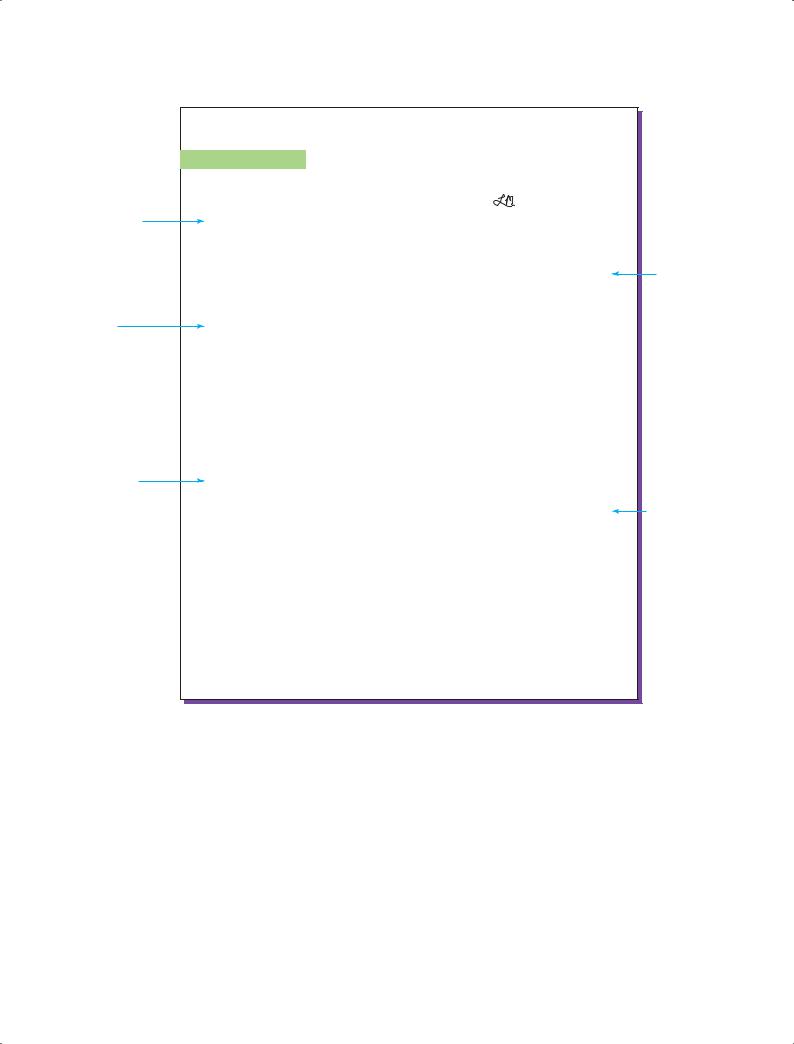
Chapter 11: Writing and Completing Reports and Proposals |
297 |
The memo
format is appropriate for this internal report; the letter format would be used
for transmitting
an external report.
The tone
is conversational yet still businesslike and respectful.
Acknowledging help given by others is good etiquette and a way to foster positive working relationships.
MEMORANDUM |
|
|
TO: |
Dennis McWilliams,Vice President of Operations |
|
FROM: |
Linda Moreno, Manager of Cost Accounting Services |
|
DATE: |
February 15, 2013 |
|
SUBJECT: Reducing Electrovision’s Travel and Entertainment Costs |
|
|
Here is the report you requested January 28 on Electrovision’s travel and entertainment |
|
|
costs. |
|
|
Your suspicions were right.We are spending far too much on business travel. Our unwritten |
Moreno expects a |
|
policy has been “anything goes,” leaving us with no real control over T&E expenses.Although |
positive response, |
|
this hands-off approach may have been understandable when Electrovision’s profits were |
so she presents her |
|
high, we can no longer afford the luxury of going first class. |
main conclusion |
|
The solutions to the problem seem rather clear.We need to have someone with centralized |
right away. |
|
|
||
responsibility for travel and entertainment costs, a clear statement of policy, an effective |
|
|
control system, and a business-oriented travel service that can optimize our travel |
|
|
arrangements.We should also investigate alternatives to travel, such as videoconferencing. |
|
|
Perhaps more important, we need to change our attitude. Instead of viewing travel funds as |
|
|
a bottomless supply of money, all traveling employees need to act as if they were paying the |
|
|
bills themselves. |
|
|
Getting people to economize is not going to be easy. In the course of researching this issue, |
|
|
I’ve found that our employees are deeply attached to their generous travel privileges. I think |
|
|
some would almost prefer a cut in pay to a loss in travel status.We’ll need a lot of top |
|
|
management involvement to sell people on the need for moderation. One thing is clear: |
|
|
People will be very bitter if we create a two-class system in which top executives get special |
|
|
privileges while the rest of the employees make the sacrifices. |
|
|
I‘m grateful to Mary Lehman and Connie McIllvain for their considerable help in rounding up |
|
|
and sorting through five years’ worth of expense reports. |
|
|
Thanks for giving me the opportunity to work on this assignment. It’s been a real education. |
She closes |
|
If you have any questions about the report, please give me a call. |
graciously, with |
|
|
|
thanks and an |
|
|
offer to discuss |
|
|
the results. |
In this report, Moreno decided to write a brief memo of transmittal and include a separate executive summary. Short reports (fewer than 10 pages) often combine the synopsis or executive summary with the memo or letter of transmittal.
Figure 11.13 (continued)
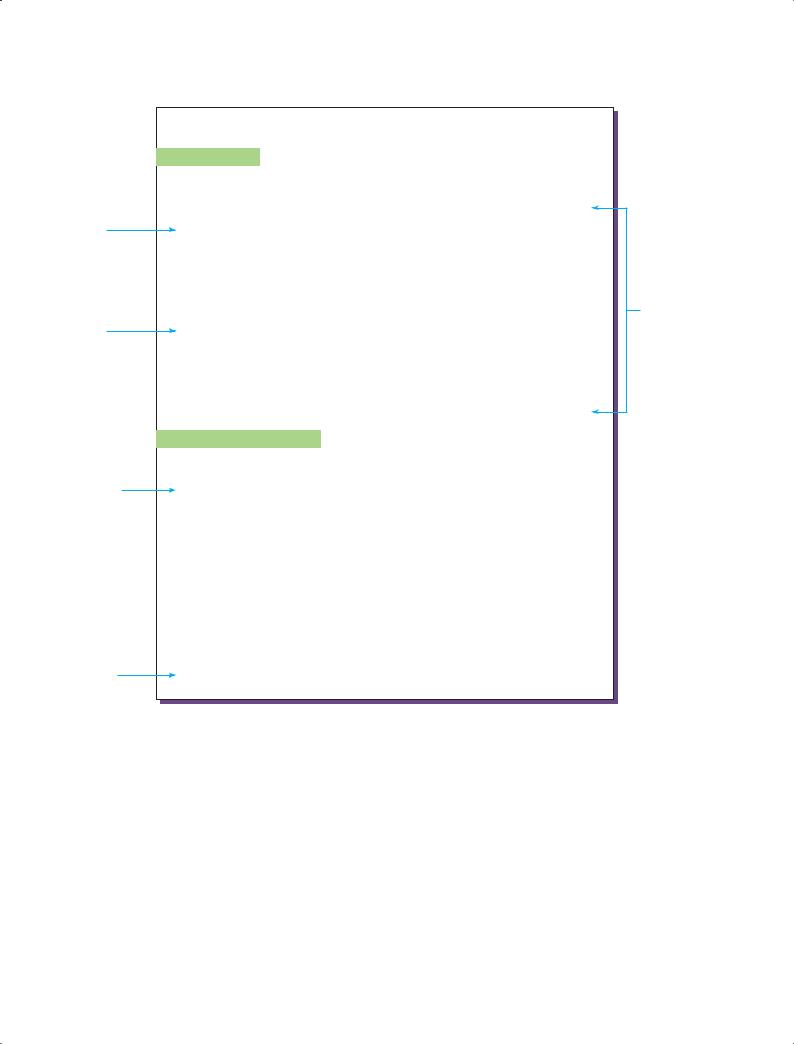
298 Unit 4: Longer Business Messages
|
CONTENTS |
|
|
|
PAGE |
|
Executive Summary . . . . . . . . . . . . . . . . . . . . . . . . . . . . . . . . . . . . . . . . . . . . . . . . . . . . . . . . . . . . . . . . . . |
. . . . iv |
The table of |
Introduction . . . . . . . . . . . . . . . . . . . . . . . . . . . . . . . . . . . . . . . . . . . . . . . . . . . . . . . . . . . . . . . . . . . . . . . . . . |
. . . . 1 |
contents doesn’t |
|
|
include any elements |
The High Cost of Travel and Entertainment . . . . . . . . . . . . . . . . . . . . . . . . . . . . . . . . . . . . . . . . . . . . . |
. . . 1 |
that appear before |
$16 Million per Year Spent on Travel and Entertainment. . . . . . . . . . . . . . . . . . . . . . . . . . . . . . . |
. . . 2 |
the “Contents” page. |
Electrovision’s Travel Expenses Exceed National Averages. . . . . . . . . . . . . . . . . . . . . . . . . . . . . |
. . . 3 |
|
Spending Has Been Encouraged . . . . . . . . . . . . . . . . . . . . . . . . . . . . . . . . . . . . . . . . . . . . . . . . . . . . . |
. . . 3 |
|
Growing Impact on the Bottom Line. . . . . . . . . . . . . . . . . . . . . . . . . . . . . . . . . . . . . . . . . . . . . . . . . . . . |
. . . 4 |
|
Lower Profits Underscore the Need for Change. . . . . . . . . . . . . . . . . . . . . . . . . . . . . . . . . . . . . . . |
. . . 4 |
The headings |
|
|
|
Airfares and Hotel Rates Are Rising . . . . . . . . . . . . . .. . . . . . . . . . . . . . . . . . . . . . . . . . . . . . . . . . . . . |
. . . 5 |
are worded |
|
|
exactly as they |
Methods for Reducing T&E Costs . . . . . . . . . . . . . . . . . . . . . . . . . . . . . . . . . . . . . . . . . . . . . . . . . . . . . . . |
. . . 5 |
appear in the text. |
Four Ways to Trim Expenses . . . . . . . . . . . . . . . . . . . . . . . . . . . . . . . . . . . . . . . . . . . . . . . . . . . . . . . . . . |
. . . 5 |
|
The Impact of Reforms . . . . . . . . . . . . . . . . . . . . . . . . . . . . . . . . . . . . . . . . . . . . . . . . . . . . . . . . . . . . . . . |
. . . 8 |
|
Conclusions and Recommendations . . . . . . . . . . . . . . . . . . . . . . . . . . . . . . . . . . . . . . . . . . . . . . . . . . . . |
. . . 9 |
|
Works Cited . . . . . . . . . . . . . . . . . . . . . . . . . . . . . . . . . . . . . . . . . . . . . . . . . . . . . . . . . . . . . . . . . . . . . . . . . . . |
. . 10 |
|
LIST OF ILLUSTRATIONS |
|
|
FIGURES |
PAGE |
Moreno lists the |
1. Airfares and Lodging Account for Over Two-Thirds of |
|
figures because |
Electrovision's T&E Budget . . . . . . . . . . . . . . . . . . . . . . . . . . . . . . . . . . . . . . . . . . . . . . . . . . . . . . . . . . . |
. . 2 |
they are all significant, |
|
|
and the list is |
2. T&E Expenses Continue to Increase |
|
fairly short. |
as a Percentage of Sales . . . . . . . . . . . . . . . . . . . . . . . . . . . . . . . . . . . . . . . . . . . . . . . . . . . . . . . . . . . . . |
. . . 2 |
|
3. Electrovision Employees Spend Over Twice as Much as |
|
|
the Average Business Traveler . . . . . . . . . . . . . . . . . . . . . . . . . . . . . . . . . . . . . . . . . . . . . . . . . . . . . . . . |
. . . 3 |
|
TABLE |
|
|
1. Electrovision Can Trim Travel and Entertainment Costs |
|
|
by an Estimated $6 Million per Year. . . . . . . . . . . . . . . . . . . . . . . . . . . . . . . . . . . . . . . . . . . . . . . . . . |
. . . 8 |
This and other |
iii |
|
prefatory pages |
|
|
are numbered |
|
|
with Roman numerals. |
|
|
|
Moreno included only firstand second-level headings in her table of contents, even though the |
|
|
report contains third-level headings. She prefers a shorter table of contents that focuses attention |
|
|
on the main divisions of thought. She used informative titles, which are appropriate for a report to |
|
|
a receptive audience. |
|
Figure 11.13 (continued)
The table lists only the page number on which a section begins, not the entire range of numbers.

Chapter 11: Writing and Completing Reports and Proposals |
299 |
The executive |
|
|
|
|
|
|
|
|
||
|
|
|
|
|
|
|
|
|||
summary begins by |
|
|
|
EXECUTIVE SUMMARY |
|
|
|
|||
stating the purpose |
|
|
|
This report analyzes Electrovision's travel and entertainment (T&E) costs and presents |
|
|||||
of the report. |
|
|
|
|
|
|||||
|
|
|
|
|
|
recommendations for reducing those costs. |
|
|||
|
|
|
|
|
|
Travel and Entertainment Costs Are Too High |
|
|||
|
|
|
|
|
|
|
||||
|
|
|
|
|
|
Travel and entertainment is a large and growing expense category for Electrovision. |
|
|||
Moreno presents |
|
|
|
The company spends over $16 million per year on business travel, and these costs have |
|
|||||
the points in the |
|
|
|
been increasing by 12 percent annually. Company employees make roughly 3,390 trips |
|
|||||
|
|
|
each year at an average cost per trip of $4,720. Airfares are the biggest expense, followed |
|
||||||
executive summary |
|
|
|
|
||||||
|
|
|
by hotels, meals, and rental cars. |
|
||||||
in the same order |
|
|
|
|
||||||
|
|
|
|
|
|
|
|
|||
as they appear in |
|
|
|
The nature of Electrovision's business does require extensive travel, but the company's |
|
|||||
the report, using |
|
|
|
costs are excessive: Our employees spend more than twice the national average on travel |
|
|||||
subheadings that |
|
|
|
and entertainment.Although the location of the company's facilities may partly explain this |
|
|||||
summarize the |
|
|
|
discrepancy, the main reason for our high costs is a management style that gives employees |
|
|||||
|
|
|
little incentive to economize. |
|
||||||
content of the main |
|
|
|
|
||||||
|
|
|
|
|
|
|
|
|||
sections of the |
|
|
|
Cuts Are Essential |
|
|||||
report. |
|
|
|
|
||||||
|
|
|
|
|
|
Electrovision management now recognizes the need to gain more control over this element |
|
|||
|
|
|
|
|
|
of costs.The company is currently entering a period of declining profits, prompting |
|
|||
|
|
|
|
|
|
management to look for every opportunity to reduce spending.At the same time, rising |
|
|||
|
|
|
|
|
|
airfares and hotel rates are making T&E expenses more significant. |
|
|||
|
|
|
|
|
|
Electrovision Can Save $6 Million per Year |
|
|||
|
|
|
|
|
|
Fortunately, Electrovision has a number of excellent opportunities for reducing T&E costs. |
|
|||
|
|
|
|
|
|
Savings of up to $6 million per year should be achievable, judging by the experience of |
|
|
||
|
|
|
|
|
|
|
|
|||
|
|
|
|
|
|
other companies.A sensible travel-management program can save companies as much as |
|
|||
|
|
|
|
|
|
35 percent a year (Gilligan 39–40), and we should be able to save even more, since we |
|
|||
|
|
|
|
|
|
purchase many more business-class tickets than the average. Four steps will help us |
|
|||
|
|
|
|
|
|
cut costs: |
|
|||
|
|
|
|
1. |
Hire a director of travel and entertainment to assume overall responsibility for T&E |
|
||||
|
|
|
|
|
|
|
spending, policies, and technologies, including the hiring and management of a national |
|
||
|
|
|
|
|
|
|
travel agency. |
|
||
|
|
|
|
2. |
Educate employees on the need for cost containment, both in avoiding |
|
||||
|
|
|
|
|
|
|
unnecessary travel and reducing costs when travel is necessary. |
|
||
|
|
|
|
|
|
3. Negotiate preferential rates with travel providers. |
|
|||
|
|
|
|
4. |
Implement technological alternatives to travel, such as virtual meetings. |
|
||||
|
|
|
|
|
|
As necessary as these changes are, they will likely hurt morale, at least in the short term. |
|
|||
|
|
|
|
|
|
Management will need to make a determined effort to explain the rationale for reduced |
|
|||
|
|
|
|
|
|
spending. By exercising moderation in their own travel arrangements, Electrovision |
|
|||
|
|
|
|
|
|
executives can set a good example and help other employees accept the changes. On the |
|
|||
|
|
|
|
|
|
plus side, using travel alternatives such as web conferencing will reduce the travel burden |
|
|||
The page |
|
|
|
|
|
on many employees and help them balance their business and personal lives. |
|
|
||
|
|
|
|
|
|
|
iv |
|
||
|
|
|
|
|
|
|
||||
numbering in the |
|
|
|
|
|
|
|
|
||
executive summary |
|
|
|
|
|
|
|
|
||
continues with |
|
|
|
|
|
|
|
|
||
Moreno decided to include an executive summary because her report is aimed at a mixed |
|
|||||||||
Roman numerals. |
|
|||||||||
audience, some of whom are interested in the details of her report and others who just want the |
|
|||||||||
|
|
|
|
|||||||
|
|
|
“big picture.” The executive summary is aimed at the second group, giving them enough infor- |
|
||||||
|
|
|
mation to make a decision without burdening them with the task of reading the entire report. |
|
||||||
|
|
|
Her writing style matches the serious nature of the content without sounding distant or stiff. |
|
||||||
|
|
|
Moreno chose the formal approach because several members of her audience are considerably |
|
||||||
|
|
|
higher up in the organization, and she did not want to sound too familiar. In addition, her |
|
||||||
|
|
|
company prefers the impersonal style for formal reports. |
|
||||||
Figure 11.13 (continued)
Her audience is receptive, so the tone in the executive summary is forceful; a more neutral approach would be better for hostile or skeptical readers.
The executive summary uses the same font and paragraph treatment as the text of the report.

300 Unit 4: Longer Business Messages
A color bar highlights the report title and the first-level
headings; a variety of other design treatments are possible as well.
A running footer that contains the report title and the
page number  appears on every
appears on every
page.
REDUCING ELECTROVISION’S
TRAVEL AND ENTERTAINMENT COSTS
INTRODUCTION
Electrovision has always encouraged a significant amount of business travel. To compensate employees for the stress and inconvenience of frequent trips, management has authorized generous travel and entertainment (T&E) allowances.This philosophy has been good for morale, but last year Electrovision spent $16 million on travel and entertainment—$7 million more than it spent on research and development.
This year’s T&E costs will affect profits even more, due to increases in airline fares and hotel rates.Also, the company anticipates that profits will be relatively weak for a variety of other reasons.Therefore, Dennis McWilliams,Vice President of Operations, has asked the accounting department to explore ways to reduce the T&E budget.
The purpose of this report is to analyze T&E expenses, evaluate the effect of recent hotel and airfare increases, and suggest ways to tighten control over T&E costs.The report outlines several steps that could reduce Electrovision's expenses, but the precise financial impact of these measures is difficult to project.The estimates presented here provide a "best guess" view of what Electrovision can expect to save.
In preparing this report, the accounting department analyzed internal expense reports for the past five years to determine how much Electrovision spends on travel and entertainment.These figures were then compared with average statistics compiled by Dow Jones (publisher of the Wall Street Journal) and presented as the Dow Jones Travel Index.We also analyzed trends and suggestions published in a variety of business journal articles to see how other companies are coping with the high cost of business travel.
THE HIGH COST OF TRAVEL AND ENTERTAINMENT
Although many companies view travel and entertainment as an incidental cost of doing business, the dollars add up.At Electrovision the bill for airfares, hotels, rental cars, meals, and entertainment totaled $16 million last year. Our T&E budget has increased by 12 percent per year for the past five years. Compared to the average U.S. business traveler, Electrovision's expenditures are high, largely because of management’s generous policy on travel benefits.
Reducing Electrovision’s Travel and Entertainment1 Costs |
|
P a g e 1 |
 The introduction opens by establishing the need for action.
The introduction opens by establishing the need for action.
 Moreno mentions her sources and methods to increase credibility and to give readers a complete picture of the study’s background.
Moreno mentions her sources and methods to increase credibility and to give readers a complete picture of the study’s background.
In her brief introduction, Moreno counts on topic sentences and transitions to indicate that she is discussing the purpose, scope, and limitations of the study.
Figure 11.13 (continued)
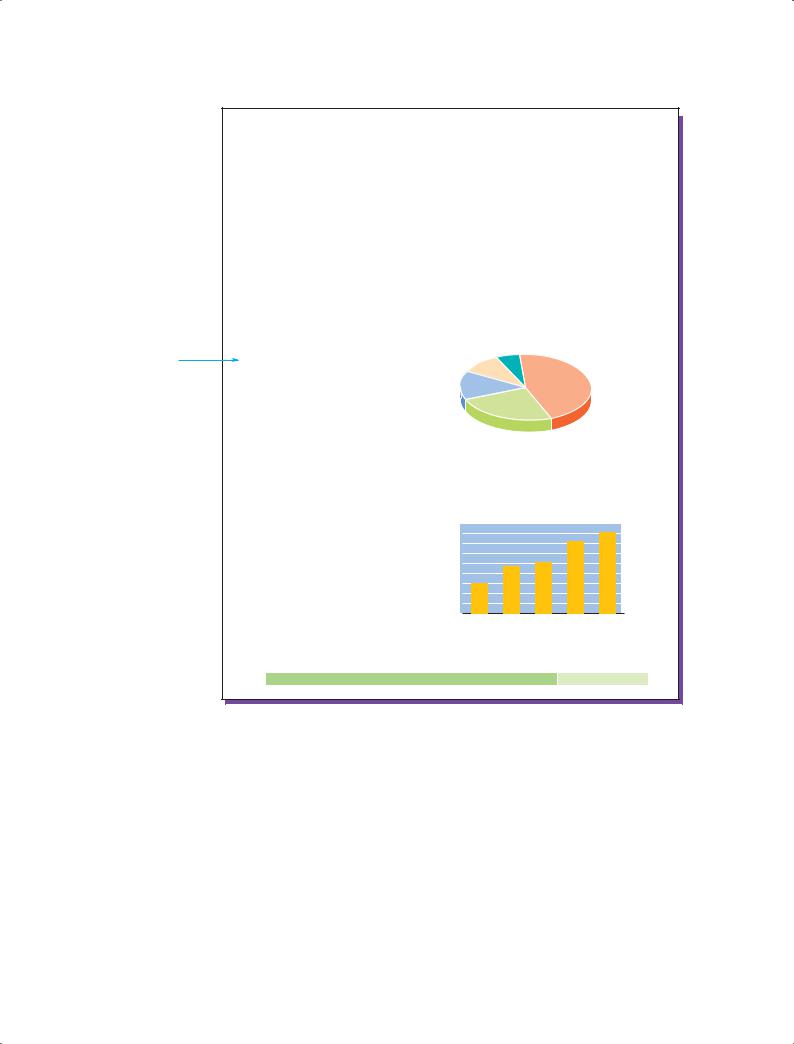
Chapter 11: Writing and Completing Reports and Proposals |
301 |
The visual is placed as close as possible to
the point it illustrates.
Each visual has a
title that clearly  indicates what it’s
indicates what it’s
about; titles are consistently placed to the left of each visual.
$16 Million per Year Spent on Travel and Entertainment
Electrovision's annual budget for travel and entertainment is only 8 percent of sales. Because this is a relatively small expense category compared with such things as salaries and commissions, it is tempting to dismiss T&E costs as insignificant. However,T&E is Electrovision's third-largest controllable expense, directly behind salaries and information systems.
Last year Electrovision personnel made about 3,390 trips at an average cost per trip of $4,720.The typical trip involved a round-trip flight of 3,000 miles, meals, and hotel accommodations for two or three days, and a rental car. Roughly 80 percent of trips were made by 20 percent of the staff—top management and sales personnel traveled most, averaging 18 trips per year.
Figure 1 illustrates how the T&E budget is spent.The largest categories are airfares and lodging, which together account for $7 out of $10 that employees spend on travel and entertainment.This spending breakdown has been relatively steady for the past five years and is consistent with the distribution of expenses experienced by other companies.
|
|
Entertainment |
|
Rental Cars |
8% |
|
Airfares |
|
Figure 1 |
10% |
43% |
|
||
Airfares and Lodging Account for Over |
|
|
Two-Thirds of Electrovision's T&E Budget |
Meals |
|
14% |
|
|
|
|
Lodging
25%
Although the composition of the T&E budget has been consistent, its size has not.As mentioned earlier, these expenditures have increased by about 12 percent per year for the past five years, roughly twice the rate of the company's sales growth (see Figure 2).This rate of growth makes T&E Electrovision's fastest-growing expense item.
Figure 2
T&E Expenses Continue to Increase as a Percentage of Sales
|
9.0% |
|
|
|
|
|
8.0% |
|
|
|
|
Sales |
7.0% |
|
|
|
|
6.0% |
|
|
|
|
|
of |
|
|
|
|
|
5.0% |
|
|
|
|
|
Percentage |
|
|
|
|
|
4.0% |
|
|
|
|
|
3.0% |
|
|
|
|
|
2.0% |
|
|
|
|
|
|
|
|
|
|
|
|
1.0% |
|
|
|
|
|
0.0% |
|
|
|
|
|
2008 |
2009 |
2010 |
2011 |
2012 |
Reducing Electrovision’s Travel and Entertainment Costs |
P a g e 2 |
Moreno opens the first main section of the body with a topic sentence that introduces an important fact about the subject of the section. Then she orients the reader to the three major points developed in the section.
Figure 11.13 (continued)
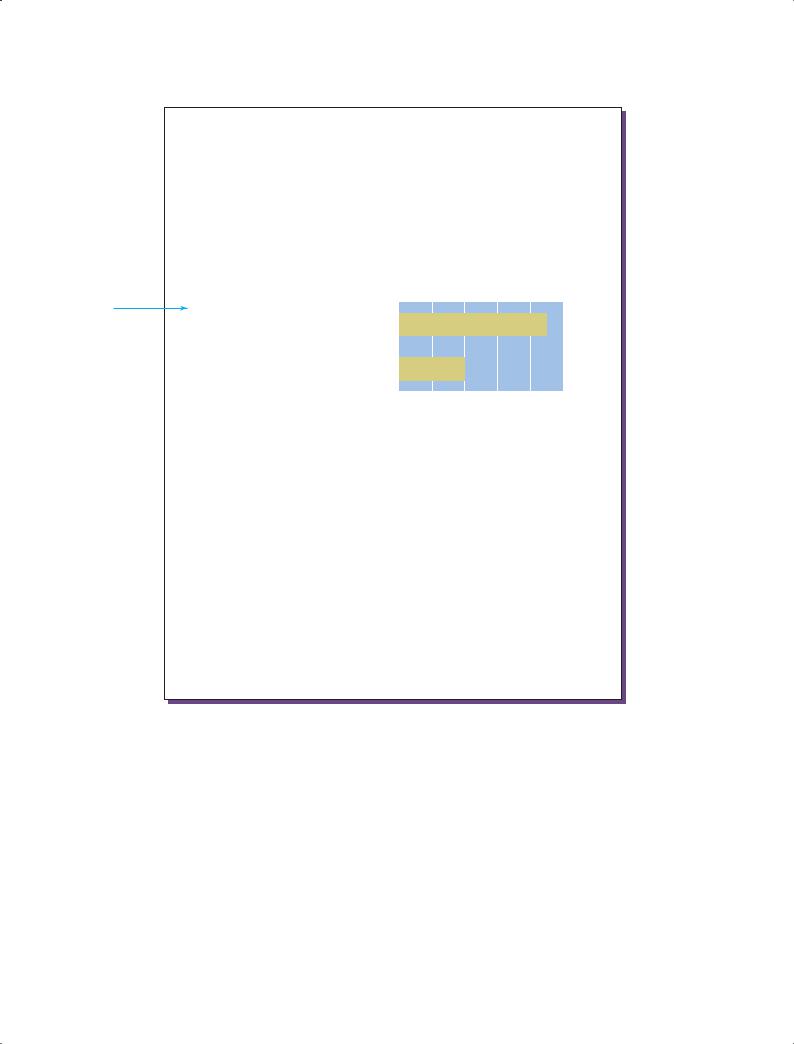
302 Unit 4: Longer Business Messages
The visuals are numbered consecutively and referred to
by their numbers in the text.
Electrovision's Travel Expenses Exceed National Averages
Much of our travel budget is justified.Two major factors contribute to Electrovision's high T&E budget:
sWith our headquarters on the West Coast and our major customer on the East Coast, we naturally spend a lot of money on cross-country flights.
sA great deal of travel takes place between our headquarters here on the West Coast
and the manufacturing operations in Detroit, Boston, and Dallas. Corporate managers and division personnel make frequent trips to coordinate these disparate operations.
However, even though a good portion of Electrovision's travel budget is justifiable, the company spends considerably more on T&E than the average business traveler (see Figure 3).
Figure 3 |
|
|
|
|
|
|
Electrovision Employees Spend Over |
Electrovision |
|
|
|
|
|
Twice as Much as the Average |
|
|
|
|
|
|
|
|
|
|
|
|
|
Business Traveler |
|
|
|
|
|
|
Source: Wall Street Journal and |
|
|
|
|
|
|
company records |
U.S.Average |
|
|
|
|
|
|
$0 |
$500 |
$1,000 |
$1,500 |
$2,000 |
$2,500 |
Dollars Spent per Day
The Dow Jones Travel Index calculates the average cost per day of business travel in the United States, based on average airfare, hotel rates, and rental car rates.The average fluctuates weekly as travel companies change their rates, but it has been running at about $1,000 per day for the last year or so. In contrast, Electrovision's average daily expense over the past year has been $2,250—a hefty 125 percent higher than average.This figure is based on the average trip cost of $4,720 listed earlier and an average trip length of 2.1 days.
Spending Has Been Encouraged
Although a variety of factors may contribute to this differential, Electrovision's relatively high T&E costs are at least partially attributable to the company's philosophy and management style. Since many employees do not enjoy business travel, management has tried to make the trips more pleasant by authorizing business-class airfare, luxury hotel accommodations, and full-size rental cars. The sales staff is encouraged to entertain clients at top restaurants and to invite them to cultural and sporting events.
Reducing Electrovision’s Travel and Entertainment Costs |
|
P a g e 3 |
 Moreno introduces visuals before they appear and indicates what readers should notice about the data.
Moreno introduces visuals before they appear and indicates what readers should notice about the data.
The chart in Figure 3 is simple but effective; Moreno includes just enough data to make her point. Notice how she is as careful about the appearance of her report as she is about the quality of
its content.
Figure 11.13 (continued)

Chapter 11: Writing and Completing Reports and Proposals |
303 |
A bulleted list makes it easy for readers to identify and distinguish related points.
The cost of these privileges is easy to overlook, given the weakness of Electrovision's system for keeping track of T&E expenses:
sThe monthly financial records do not contain a separate category for travel and entertainment; the information is buried under Cost of Goods Sold and under Selling, General, and Administrative Expenses.
sEach department head is given authority to approve any expense report, regardless of how large it may be.
sReceipts are not required for expenditures of less than $100.
sIndividuals are allowed to make their own travel arrangements.
sNo one is charged with the responsibility for controlling the company's total spending on travel and entertainment.
GROWING IMPACT ON THE BOTTOM LINE
During the past three years, the company's healthy profits have resulted in relatively little pressure to push for tighter controls over all aspects of the business. However, as we all know, the situation is changing.We're projecting flat to declining profits for the next two years, a situation that has prompted all of us to search for ways to cut costs.At the same time, rising airfares and hotel rates have increased the impact of T&E expenses on the company's financial results.
Lower Profits Underscore the Need for Change
The next two years promise to be difficult for Electrovision.After several years of steady increases in spending, the Postal Service is tightening procurement policies for automated mail-handling equipment. Funding for the A-12 optical character reader has been canceled. As a consequence, the marketing department expects sales to drop by 15 percent.Although Electrovision is negotiating several other promising R&D contracts, the marketing department does not foresee any major procurements for the next two to three years.
At the same time, Electrovision is facing cost increases on several fronts.As we have known for several months, the new production facility now under construction in Salt Lake City, Utah, is behind schedule and over budget. Labor contracts in Boston and Dallas will expire within the next six months, and plant managers there anticipate that significant salary and benefits concessions may be necessary to avoid strikes.
Moreover, marketing and advertising costs are expected to increase as we attempt to strengthen these activities to better cope with competitive pressures. Given the expected decline in revenues and increase in costs, the Executive Committee's prediction that profits will fall by 12 percent in the coming fiscal year does not seem overly pessimistic.
Reducing Electrovision’s Travel and Entertainment Costs |
|
P a g e 4 |
Moreno designed her report to include plenty of white space so even those pages that lack visuals are still attractive and easy to read.
Figure 11.13 (continued)
Informative headings focus reader attention on the main points. Such headings are appropriate when a report uses the direct order and is intended for a receptive audience. However, descriptive headings are more effective when a report uses the indirect order
and readers are less receptive.

304 Unit 4: Longer Business Messages
Moreno supports  her argument with
her argument with
objective facts and sound reasoning.
The recommendations  are realistic, noting
are realistic, noting
both the benefits and the risks of taking action.
Airfares and Hotel Rates Are Rising
Business travelers have grown accustomed to frequent fare wars and discounting in the travel industry in recent years. Excess capacity and aggressive price competition, particularly in the airline business, made travel a relative bargain.
However, that situation has changed as weaker competitors have been forced out and the remaining players have grown stronger and smarter.Airlines and hotels are better at managing inventory and keeping occupancy rates high, which translates into higher costs for Electrovision. Last year saw some of the steepest rate hikes in years. Business airfares (tickets most likely to be purchased by business travelers) jumped more than 40 percent in many markets.The trend is expected to continue, with rates increasing another 5 to 10 percent overall (Phillips 331; "Travel Costs Under Pressure" 30; Dahl B6).
Given the fact that air and hotel costs account for almost 70 percent of our T&E budget, the trend toward higher prices in these two categories will have serious consequences, unless management takes action to control these costs.
METHODS FOR REDUCING T&E COSTS
By implementing a number of reforms, management can expect to reduce Electrovision's T&E budget by as much as 40 percent.This estimate is based on the general assessment made by American Express (Gilligan 39) and on the fact that we have an opportunity to significantly reduce air travel costs by eliminating business-class travel. However, these measures are likely to be unpopular with employees.To gain acceptance for such changes, management will need to sell employees on the need for moderation in T&E allowances.
Four Ways to Trim Expenses
By researching what other companies are doing to curb T&E expenses, the accounting department has identified four prominent opportunities that should enable Electrovision to save about $6 million annually in travel-related costs.
Institute Tighter Spending Controls
A single individual should be appointed director of travel and entertainment to spearhead the effort to gain control of the T&E budget. More than a third of all U.S. companies now employ travel managers ("Businesses Use Savvy Managers" 4).The director should be familiar with the travel industry and should be well versed in both accounting and information technology.The director should also report to the vice president of operations. The director's first priorities should be to establish a written T&E policy and a cost-control system.
Electrovision currently has no written policy on travel and entertainment, a step that is widely recommended by air travel experts (Smith D4). Creating a policy would clarify management's position and serve as a vehicle for communicating the need for moderation.
Reducing Electrovision’s Travel and Entertainment Costs |
|
P a g e 5 |
Moreno creates a forceful tone by using action verbs in the third-level subheadings of this section. This approach is appropriate to the nature of the study and the attitude of the audience. However, in a status-conscious organization, the imperative verbs might sound a bit too presumptuous coming from a junior member of the staff.
Figure 11.13 (continued)

Chapter 11: Writing and Completing Reports and Proposals |
305 |
In addition to making key points
easy to find, bulleted lists help break up the text to relieve the reader’s eye.
At a minimum, the policy should include the following:
sAll travel and entertainment should be strictly related to business and should be approved in advance.
sExcept under special circumstances to be approved on a case-by-case basis, employees should travel by coach and stay in mid-range business hotels.
sThe T&E policy should apply equally to employees at all levels.
To implement the new policy, Electrovision will need to create a system for controlling T&E expenses. Each department should prepare an annual T&E budget as part of its operating plan.These budgets should be presented in detail so that management can evaluate how T&E dollars will be spent and can recommend appropriate cuts.To help management monitor performance relative to these budgets, the director of travel should prepare monthly financial statements showing actual T&E expenditures by department.
The director of travel should also be responsible for retaining a business-oriented travel service that will schedule all employee business trips and look for the best travel deals, particularly in airfares. In addition to centralizing Electrovision's reservation and ticketing activities, the agency will negotiate reduced group rates with hotels and rental car firms.The agency selected should have offices nationwide so that all Electrovision facilities can channel their reservations through the same company.This is particularly important in light of the dizzying array of often wildly different airfares available between some cities. It's not uncommon to find dozens of fares along commonly traveled routes (Rowe 30). In addition, the director can help coordinate travel across the company to secure group discounts whenever possible (Barker 31; Miller B6).
Reduce Unnecessary Travel and Entertainment
One of the easiest ways to reduce expenses is to reduce the amount of traveling and entertaining that occurs.An analysis of last year's expenditures suggests that as much as 30 percent of Electrovision's travel and entertainment is discretionary.The professional staff spent $2.8 million attending seminars and conferences last year.Although these gatherings are undoubtedly beneficial, the company could save money by sending fewer representatives to each function and perhaps by eliminating some of the less valuable seminars.
Similarly, Electrovision could economize on trips between headquarters and divisions by reducing the frequency of such visits and by sending fewer people on each trip.Although there is often no substitute for face-to-face meetings, management could try to resolve more internal issues through telephone, electronic, and written communication.
Electrovision can also reduce spending by urging employees to economize. Instead of flying business class, employees can fly coach class or take advantage of discount fares. Rather than ordering a $50 bottle of wine, employees can select a less expensive bottle or dispense with
Reducing Electrovision’s Travel and Entertainment Costs |
|
P a g e 6 |
Moreno takes care not to overstep the boundaries of her analysis. For instance, she doesn’t analyze the value of the seminars that employees attend every year, so she avoids any absolute statements about reducing travel to seminars.
Figure 11.13 (continued)
Moreno lists the steps needed to implement her
recommendations.

306 Unit 4: Longer Business Messages
By pointing out possible difficulties and
showing that she has considered
all angles, Moreno builds reader confidence in
her judgment.
Figure 11.13 (continued)
alcohol entirely. People can book rooms at moderately priced hotels and drive smaller rental cars.
Obtain Lowest Rates from Travel Providers
Apart from urging employees to economize, Electrovision can also save money by searching for the lowest available airfares, hotel rates, and rental car fees. Currently, few employees have the time or knowledge to seek out travel bargains.When they need to travel, they make the most convenient and comfortable arrangements.A professional travel service will be able to obtain lower rates from travel providers.
Judging by the experience of other companies, Electrovision may be able to trim as much as 30 to 40 percent from the travel budget simply by looking for bargains in airfares and negotiating group rates with hotels and rental car companies. Electrovision should be able to achieve these economies by analyzing its travel patterns, identifying frequently visited locations, and selecting a few hotels that are willing to reduce rates in exchange for guaranteed business.At the same time, the company should be able to save up to 40 percent on rental car charges by negotiating a corporate rate.
The possibilities for economizing are promising; however, making the best travel arrangements often requires trade-offs such as the following:
sThe best fares might not always be the lowest. Indirect flights are usually cheaper, but they take longer and may end up costing more in lost work time.
sThe cheapest tickets often require booking 14 or even 30 days in advance, which is often impossible for us.
sDiscount tickets are usually nonrefundable, which is a serious drawback when a trip needs to be canceled at the last minute.
Replace Travel with Technological Alternatives
Online meeting systems such as WebEx and GoTo Meeting offer a compelling alternative to many instances of business travel.With webcam video, application/screen sharing, and collaboration tools such as virtual whiteboards, they have made great strides toward replicating the in-person meeting experience.
As effective as they can be, though, they shouldn’t automatically replace every in-person meeting.When establishing a business relationship, for example, meeting face to face is an important part of building trust and getting past the uncertainties of working with a new partner. Part of the new travel director’s job would be to draft guidelines for choosing travel or on-line meeting options.
Reducing Electrovision’s Travel and Entertainment Costs |
|
P a g e 7 |
Note how Moreno makes the transition from section to section. The first sentence under the second heading on this page refers to the subject of the previous paragraph and signals a shift in thought.

Chapter 11: Writing and Completing Reports and Proposals |
307 |
An informative title
in the table is  consistent with the
consistent with the
way headings are handled throughout this report, and it is appropriate for a report to a receptive audience.
The Impact of Reforms
By implementing tighter controls, reducing unnecessary expenses, negotiating more favorable rates, and exploring alternatives to travel, Electrovision should be able to reduce its T&E budget significantly.As Table 1 illustrates, the combined savings should be in the neighborhood of $6 million, although the precise figures are somewhat difficult to project.
Table 1
Electrovision Can Trim Travel and Entertainment Costs by an Estimated $6 Million per Year
SOURCE OF SAVINGS |
ESTIMATED SAVINGS |
|
Switching from business-class to coach airfare |
$2,300,000 |
|
Negotiating preferred hotel rates |
940,000 |
|
Negotiating preferred rental car rates |
460,000 |
|
Systematically searching for lower airfares |
375,000 |
|
Reducing interdivisional travel |
675,000 |
|
Reducing seminar and conference attendance |
1,250,000 |
|
TOTAL POTENTIAL SAVINGS |
$6,000,000 |
|
To achieve the economies outlined in the table, Electrovision will incur expenses for hiring a director of travel and for implementing a T&E cost-control system.These costs are projected at $115,000: $105,000 per year in salary and benefits for the new employee and
a one-time expense of $10,000 for the cost-control system.The cost of retaining a full-service travel agency is negligible, even with the service fees that many are now passing along from airlines and other service providers.
The measures required to achieve these savings are likely to be unpopular with employees. Electrovision personnel are accustomed to generous T&E allowances, and they are likely to resent having these privileges curtailed.To alleviate their disappointment
sManagement should make a determined effort to explain why the changes are necessary.
sThe director of corporate communication should be asked to develop a multifaceted campaign that will communicate the importance of curtailing T&E costs.
sManagement should set a positive example by adhering strictly to the new policies.
sThe limitations should apply equally to employees at all levels in the organization.
Reducing Electrovision’s Travel and Entertainment Costs |
|
P a g e 8 |
Note how Moreno calls attention in the first paragraph to items in the following table, without repeating the information in the table.
Figure 11.13 (continued)
The in-text reference to the table highlights the key point the reader should get from the table.
Including financial estimates helps management envision the impact of the suggestions, even
though the estimated savings are difficult to project accurately.

308 Unit 4: Longer Business Messages
She uses a descriptive  heading for the last
heading for the last
section of the text. In informational reports, this section is often called “Summary”; in analytical reports, it is called “Conclusions” or “Conclusions and Recommendations.”
Presenting the recommendations in a list gives each one emphasis.
CONCLUSIONS AND RECOMMENDATIONS
Electrovision is currently spending $16 million per year on travel and entertainment. Although much of this spending is justified, the company's costs are high relative to competitors' costs, mainly because Electrovision has been generous with its travel benefits.
Electrovision's liberal approach to travel and entertainment was understandable during years of high profitability; however, the company is facing the prospect of declining profits for the next several years. Management is therefore motivated to cut costs in all areas of the business. Reducing T&E spending is particularly important because the bottom-line impact of these costs will increase as airline fares increase.
Electrovision should be able to reduce T&E costs by as much as 40 percent by taking four important steps:
1.Institute tighter spending controls. Management should hire a director of travel and entertainment who will assume overall responsibility for T&E activities.Within the next six months, this director should develop a written travel policy, institute a T&E budget and a cost-control system, and retain a professional, business-oriented travel agency that will optimize arrangements with travel providers.
2.Reduce unnecessary travel and entertainment. Electrovision should encourage employees to economize on T&E spending. Management can accomplish this by authorizing fewer trips and by urging employees to be more conservative in their spending.
3.Obtain lowest rates from travel providers. Electrovision should also focus on obtaining the best rates on airline tickets, hotel rooms, and rental cars. By channeling all arrangements through a professional travel agency, the company can optimize its choices and gain clout in negotiating preferred rates.
4.Replace some travel with technological alternatives. Online meeting systems should be adequate for most of our tactical meetings with established clients and for most internal communication as well.
Because these measures may be unpopular with employees, management should make a concerted effort to explain the importance of reducing travel costs.The director of corporate communication should be given responsibility for developing a plan to communicate the need for employee cooperation.
Reducing Electrovision’s Travel and Entertainment Costs |
|
P a g e 9 |
Moreno doesn’t introduce any new facts in this section. In a longer report she might have divided this section into subsections, labeled “Conclusions” and “Recommendations,” to distinguish between the two.
Figure 11.13 (continued)
Moreno summarizes her conclusions in the first two paragraphs—a good approach because she organized her report around conclusions and recommendations, so readers have already been introduced to them.

Chapter 11: Writing and Completing Reports and Proposals |
309 |
MLA style lists references alphabetically by the author’s last name, and when the author is unknown, by the title of the reference. (See Appendix B for additional details on preparing reference lists.)
WORKS CITED
Barker, Julie.“How to Rein in Group Travel Costs.” Successful Meetings Feb. 2011: 31. Print.
“Businesses Use Savvy Managers to Keep Travel Costs Down.” Christian Science Monitor 17 July 2008: 4. Print.
Dahl, Jonathan.“2000:The Year Travel Costs Took Off.” Wall Street Journal 29 Dec. 2007: B6. Print.
Gilligan, Edward P.“Trimming Your T&E Is Easier Than You Think.” Managing Office Technology Nov. 2011: 39–40. Print.
Miller, Lisa.“Attention,Airline Ticket Shoppers.” Wall Street Journal 7 July 2010: B6. Print.
Phillips, Edward H.“Airlines Post Record Traffic.” Aviation Week & Space Technology 8 Jan. 2010: 331. Print.
“Product Overview: Cisco WebEx Meeting Center,” Webex.com. 2011.WebEx, n.d. 2 February 2012. Web.
Rowe, Irene Vlitos.“Global Solution for Cutting Travel Costs.” European Business 12 Oct. 2011: 30. Print.
Smith, Carol.“Rising, Erratic Airfares Make Company Policy Vital.” Los Angeles Times 2 Nov. 2010: D4. Print.
Solheim, Shelley.“Web Conferencing Made Easy.” eWeek 22 Aug. 2008: 26. Web.
“Travel Costs Under Pressure.” Purchasing 15 Feb. 2012: 30. Print.
Moreno’s list of references follows the style recommended in the MLA Style Manual. The box below shows how these sources would be cited following APA style.
REFERENCES
Barker, J. (2011, February). How to rein in group travel costs. Successful Meetings, p. 31.
Businesses use savvy managers to keep travel costs down. (2008, July 17). Christian Science Monitor, p. 4.
Dahl, J. (2007, December 29). 2000:The year travel costs took off. Wall Street Journal, B6.
Gilligan, E. (2011, November).Trimming your T&E is easier than you think. Managing Office Technology, pp. 39–40.
Miller, L. (2010, July 7).Attention, airline ticket shoppers. Wall Street Journal, B6.
Phillips, E. (2010, January 8).Airlines post record traffic. Aviation Week & Space Technology, p. 331. Rowe, I. (2011, October 12). Global solution for cutting travel costs. European, p. 30.
Smith, C. (2010, November 2). Rising, erratic airfares make company policy vital.
Los Angeles Times, D4.
Solheim, S. (2008,August 22).Web conferencing made easy. eWeek, p. 26.
Travel costs under pressure. (2012, February 15). Purchasing, p. 30.
WebEx.com. (2012). Product Overview: Cisco WebEx Meeting Center. Retrieved
from http://www.webex.com/product-overview/index.html
Figure 11.13 (continued)
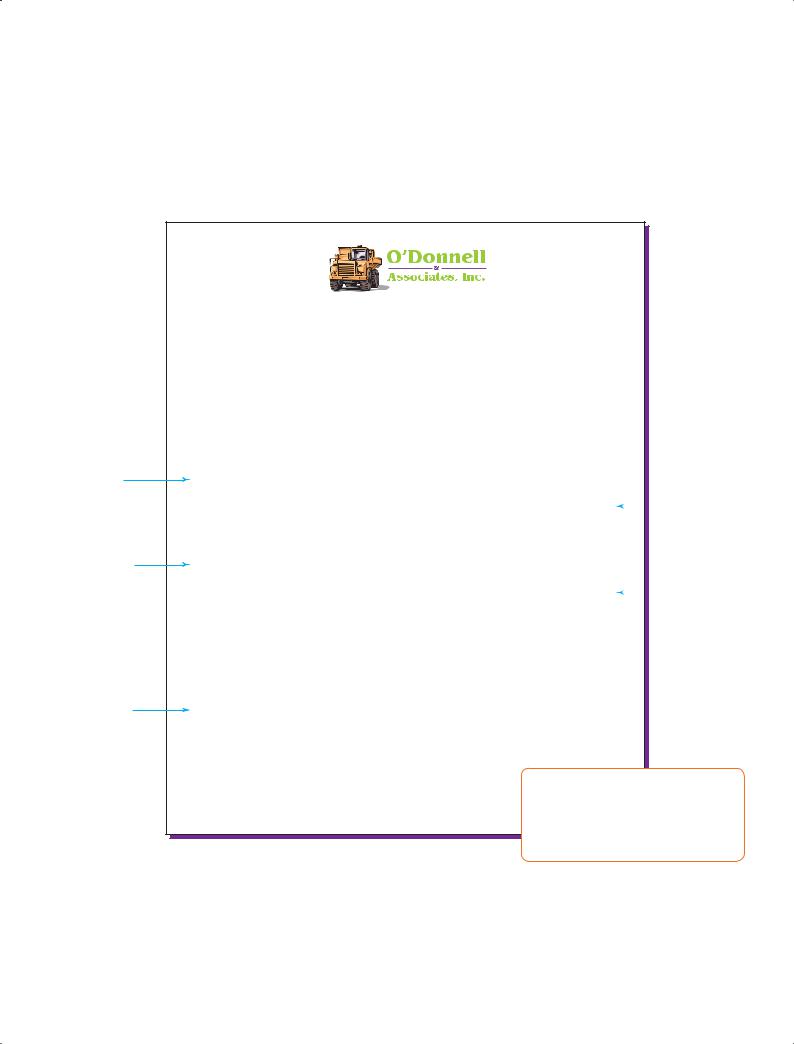
310 Unit 4: Longer Business Messages
Just as with reports, the text of a proposal is composed of an introduction, a body, and a close. The introduction presents and summarizes the problem you intend to solve and your solution. It highlights the benefits the reader will receive from the solution. The body explains the complete details of the solution: how the job will be done, how it will be broken into tasks, what method will be used to do it (including the required equipment, material, and personnel), when the work will begin and end, how much the work will cost, and why your company is qualified (for external proposals). The close emphasizes the benefits readers will realize from your solution and ends with a persuasive call to action (see Figure 11.14).
The opening paragraph serves
as an introduction.
Headings divide the proposal into logical segments for easy reading.
The work plan describes the
scope of the project and outlines specific tests the company will perform.
1793 East Westerfield Road, Arlington Heights, Illinois 60005 (847) 398-1148 Fax: (847) 398-1149 Email: dod@ix.netcom.com
July 30, 2012
Ms. Joyce Colton, P.E.
AGI Builders, Inc.
1280 Spring Lake Drive
Belvidere, Illinois, 61008
Subject: Proposal No. F-0087 for AGI Builders, Elgin Manufacturing Campus
Dear Ms. Colton: |
|
|
|
O’Donnell & Associates is pleased to submit the following proposal to provide |
|
|
|
construction testing services for the mass grading operations and utility work at the Elgin |
|
|
|
Manufacturing Campus, 126th St., Elgin, Illinois. Our company has been providing |
|
|
|
construction-testing services in the Chicago area since 1972 and has performed numerous |
|
|
|
large-scale geotechnical investigations across Illinois, including more than 100 at O'Hare |
|
The introduction |
|
International Airport, Midway Airport, Meig's Field, and other airports. |
|
||
|
grabs the reader’s |
||
|
|
|
|
|
|
|
attention by |
Background |
|
|
highlighting |
|
|
company |
|
|
|
|
|
It is our understanding that the work consists of two projects: (1) the mass grading |
|
qualifications. |
|
|
|
||
operations will require approximately six months, and (2) the utility work will require |
|
|
|
approximately three months.The two operations are scheduled as follows: |
|
The project |
|
|
|||
Mass Grading Operation |
September 2012–February 2013 |
|
background |
|
section |
||
Utility Work |
March 2013–May 2013 |
|
|
|
acknowledges |
||
|
|
|
|
|
|
|
the two projects |
Proposed Approach and Work Plan |
|
|
and their |
|
|
required timeline. |
|
|
|
|
|
O’Donnell & Associates will perform observation and testing services during both the mass grading operations and the excavation and backfilling of the underground utilities. Specifically, we will perform field density tests on the compacted material as required by the job specifications using a nuclear moisture/density gauge.We will also conduct appropriate laboratory tests such as ASTM D-1557 Modified Proctors.We will prepare detailed reports summarizing the results of our field and laboratory testing. Fill materials to be placed at the site may consist of natural granular materials (sand), processed materials (crushed stone, crushed concrete, slag), or clay soils. O’Donnell & Associates will provide qualified personnel to perform the necessary testing.
MyBCommLab Apply Figure 11.14’s
key concepts. Go to mybcommlab
.com and follow this path: Course Content Chapter 11 DOCUMENT
MAKEOVERS
Figure 11.14 External Solicited Proposal
This proposal was submitted by Dixon O’Donnell, vice president of O’Donnell & Associates, a geotechnical (continued) engineering firm that conducts a variety of environmental testing services. The company is bidding on the mass
grading and utility work specified by AGI Builders. As you review this document, pay close attention to the specific items addressed in the proposal’s introduction, body, and closing.

Chapter 11: Writing and Completing Reports and Proposals |
311 |
|
|
|
|
|
Ms. Joyce Colton, AGI Builders |
Page 2 |
July 30, 2012 |
|
|
|
|||
|
|
|
|
|
|
|
|
||||||
The work plan also |
|
|
|
Kevin Patel will be the lead field technician responsible for the project.A copy of Mr. |
|
|
|
||||||
|
|
|
|
|
|
||||||||
explains who will be |
|
|
Patel’s résumé is included with this proposal for your review. Kevin will coordinate field |
|
|
|
|
The project leader’s |
|||||
|
|
|
|
|
|||||||||
responsible for the |
|
|
activities with your job site superintendent and make sure that appropriate personnel are |
|
|
résumé is attached |
|||||||
various tasks. |
|
|
assigned to the job site. Overall project management will be the responsibility of Joseph |
|
|
to the proposal, |
|||||||
|
|
|
|
|
Proesel. Project engineering services will be performed under the direction of Dixon |
|
|
providing additional |
|||||
|
|
|
|
|
O’Donnell, P.E.All field personnel assigned to the site will be familiar with and abide by |
|
|
detail without cluttering |
|||||
|
|
|
|
|
the Project Site Health and Safety Plan prepared by Carlson Environmental, Inc., dated |
|
|
up the body of |
|||||
|
|
|
|
|
April 2012. |
|
|
|
|
|
|
the proposal. |
|
|
|
|
|
|
Qualifications |
|
|
|
|
|
|
|
|
|
|
|
|
|
O’Donnell & Associates has been providing quality professional services since 1972 in the |
|
|
|
|||||
The qualifications |
|
|
areas of |
|
|
|
|
|
|
|
|||
|
|
|
|
|
|
|
|
|
|
|
|||
section grabs |
|
|
|
ss |
'EOTEChnical engineering |
|
|
|
|
|
|
|
|
|
|
|
|
|
|
|
|
|
|
||||
attention by |
|
|
ss |
-ATERials testing and inspection |
|
|
|
|
|
|
|
||
mentioning |
|
|
ss |
Pavement evaluation |
|
|
|
|
|
|
|
||
compelling |
|
|
ss |
%NVIRONMENTALRSErvices |
|
|
|
|
|
|
|
||
qualifications. |
|
|
ss |
%NGINEERing and technical support (CADD) services |
|
|
|
|
|
|
|||
|
|
|
|
|
The company provides Phase I and Phase II environmental site assessments, preparation |
|
|
|
|||||
|
|
|
|
|
of LUST site closure reports, installation of groundwater monitoring wells, and testing of |
|
|
|
|||||
|
|
|
|
|
soil/groundwater samples for environmental contaminants. Geotechnical services include |
|
|
|
|||||
|
|
|
|
|
all phases of soil mechanics and foundation engineering, including foundation and lateral |
|
|
|
|||||
|
|
|
|
|
load analysis, slope stability analysis, site preparation recommendations, seepage analysis, |
|
|
|
|||||
|
|
|
|
|
pavement design, and settlement analysis. |
|
|
|
|
|
|
|
|
|
|
|
|
|
O'Donnell & Associates materials testing laboratory is certified by AASHTO Accreditation |
|
|
|
|||||
|
|
|
|
|
Program for the testing of Soils,Aggregate, Hot Mix Asphalt and Portland Cement |
|
|
|
|||||
|
|
|
|
|
Concrete.A copy of our laboratory certification is included with this proposal. In addition |
|
|
|
Describing certifications |
||||
|
|
|
|
|
|
|
|
||||||
|
|
|
|
|
to in-house training, field and laboratory technicians participate in a variety of certification |
|
|
(approvals by recognized |
|||||
|
|
|
|
|
programs, including those sponsored by the American Concrete Institute (ACI) and Illinois |
|
|
industry associations |
|||||
|
|
|
|
|
Department of Transportation (IDOT). |
|
|
|
|
|
|
or government agencies) |
|
|
|
|
|
|
|
|
|
|
|
|
|
|
helps build the |
|
|
|
|
|
|
|
|
|
|
|
|
|
company’s credibility. |
|
|
|
|
|
Costs |
|
|
|
|
|
|
|
|
|
|
|
|
|
On the basis of our understanding of the scope of the work, we estimate the total cost of |
|
|
|
|||||
|
|
|
|
|
the two projects to be $100,260.00, as follows: |
|
|
|
|
|
|
||
|
|
|
|
|
|
|
|
|
|
|
|
|
|
|
|
|
|
|
|
|
|
|
|
|
|
|
|
Figure 11.14 (continued)

312 Unit 4: Longer Business Messages
|
|
|
|
Ms. Joyce Colton, AGI Builders |
Page 3 |
|
|
July 30, 2012 |
|
|||
|
|
|
|
|
|
|
||||||
|
|
|
|
|
Cost Estimates |
|
|
|
|
|
|
|
|
|
|
|
|
|
|
|
|
|
|
|
|
|
|
|
|
|
Cost Estimate: Mass Grading |
Units |
Rate ($) |
Total Cost ($) |
|
|||
|
|
|
|
|
|
|
|
|
|
|
|
|
|
|
|
|
|
Field Inspection |
|
|
|
|
|
|
|
|
|
|
|
|
Labor |
1,320 hours |
$38.50 |
$ |
50,820.00 |
|
|
|
|
|
|
|
|
Nuclear Moisture Density Meter |
132 days |
35.00 |
|
4,620.00 |
|
|
|
|
|
|
|
|
Vehicle Expense |
132 days |
45.00 |
|
5,940.00 |
|
|
|
|
|
|
|
|
Laboratory Testing |
|
|
|
|
|
|
|
|
|
|
|
|
Proctor Density Tests |
4 tests |
130.00 |
|
520.00 |
|
|
|
|
|
|
|
|
(ASTM D-1557) |
|
|
|
|
|
|
|
|
|
|
|
|
Engineering/Project Management |
|
|
|
|
|
|
|
|
|
|
|
|
Principal Engineer |
16 hours |
110.00 |
|
1,760.00 |
|
|
|
|
|
|
|
|
Project Manager |
20 hours |
80.00 |
|
1,600.00 |
|
|
|
|
|
|
|
|
Administrative Assistant |
12 hours |
50.00 |
|
600.00 |
|
|
|
|
|
|
|
|
Subtotal |
|
|
$ |
65,860.00 |
|
|
|
A clear and |
|
|
|
|
|
|
|
|
|
|
|
|
|
|
|
|
Cost Estimate: Utility Work |
Units |
Rate ($) |
Total Cost ($) |
|
||||
|
|
|
|
|
||||||||
complete itemization |
|
|
|
|
|
|
|
|
|
|
|
|
|
|
|
Field Inspection |
|
|
|
|
|
|
|
||
of estimated costs |
|
|
|
660 hours |
$ 38.50 |
$ 25,410.00 |
|
|
|
|||
builds confidence in |
|
|
|
Labor |
|
|
|
|||||
dependability of the |
|
|
|
Nuclear Moisture Density Meter |
66 days |
5.00 |
|
2,310.00 |
|
|
|
|
project’s financial |
|
|
|
Vehicle Expense |
66 days |
45.00 |
|
2,970.00 |
|
|
|
|
projections. |
|
|
|
Laboratory Testing |
2 tests |
130.00 |
|
260.00 |
|
|
|
|
|
|
|
|
|
Proctor Density Tests |
|
|
|
|
|||
|
|
|
|
|
(ASTM D-1557) |
|
|
|
|
|
|
|
|
|
|
|
|
Engineering/Project Management |
|
110.00 |
|
1,100.00 |
|
|
|
|
|
|
|
|
Principal Engineer |
10 hours |
|
|
|
|
||
|
|
|
|
|
Project Manager |
20 hours |
80.00 |
|
1,600.00 |
|
|
|
|
|
|
|
|
Administrative Assistant |
15 hours |
50.00 |
|
750.00 |
|
|
|
|
|
|
|
|
Subtotal |
|
|
$ |
34,400.00 |
|
|
|
|
|
|
|
|
|
|
|
|
|
|
|
|
|
|
|
|
|
Total Project Costs |
|
|
$100,260.00 |
|
|
|
|
|
|
|
|
|
|
|
|
|
||||
|
|
|
|
This estimate assumes full-time inspection services. However, our services may also be |
|
|||||||
|
|
|
|
performed on an as-requested basis, and actual charges will reflect time associated with the |
|
|
||||||
|
|
|
|
|
|
|||||||
|
|
|
|
project.We have attached our standard fee schedule for your review. Overtime rates are for |
|
|||||||
|
|
|
|
hours in excess of 8.0 hours per day, before 7:00 a.m., after 5:00 p.m., and on holidays and |
|
|||||||
|
|
|
|
weekends. |
|
|
|
|
|
|
|
|
|
|
|
|
|
|
|
|
|
|
|
|
|
|
|
|
|
|
|
|
|
|
|
|
|
|
Figure 11.14 (continued)
To give the client some budgetary flexibility, the proposal offers an alternative to the fixed-fee approach—which may lower any resistance to accepting the bid.

The brief
close emphasizes the bidder’s qualifications
and asks for a decision.
Chapter 11: Writing and Completing Reports and Proposals |
313 |
Ms. Joyce Colton, AGI Builders |
Page 4 |
July 30, 2012 |
Authorization
With a staff of over 30 personnel, including registered professional engineers, resident engineers, geologists, construction inspectors, laboratory technicians, and drillers, we are confident that O’Donnell & Associates is capable of providing the services required for a project of this magnitude.
If you would like our firm to provide the services as outlined in this proposal, please sign this letter and return it to us along with a certified check in the amount of $10,000 (our retainer) by August 14, 2011. Please call me if you have any questions regarding the terms of this proposal or our approach.
Sincerely,
Dixon O’Donnell
Vice President
Enclosures
Accepted for AGI BUILDERS, INC.
By__________________________________ Date ________________________________
The call to action clarifies the steps needed to put the project in motion.
The customer’s signature will make the proposal a binding contract.
Figure 11.14 (continued)
